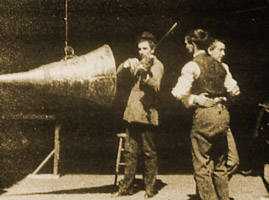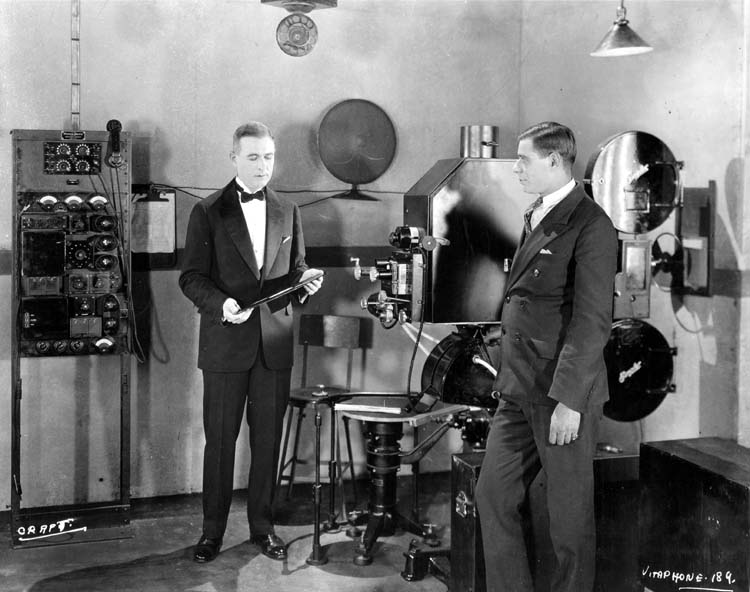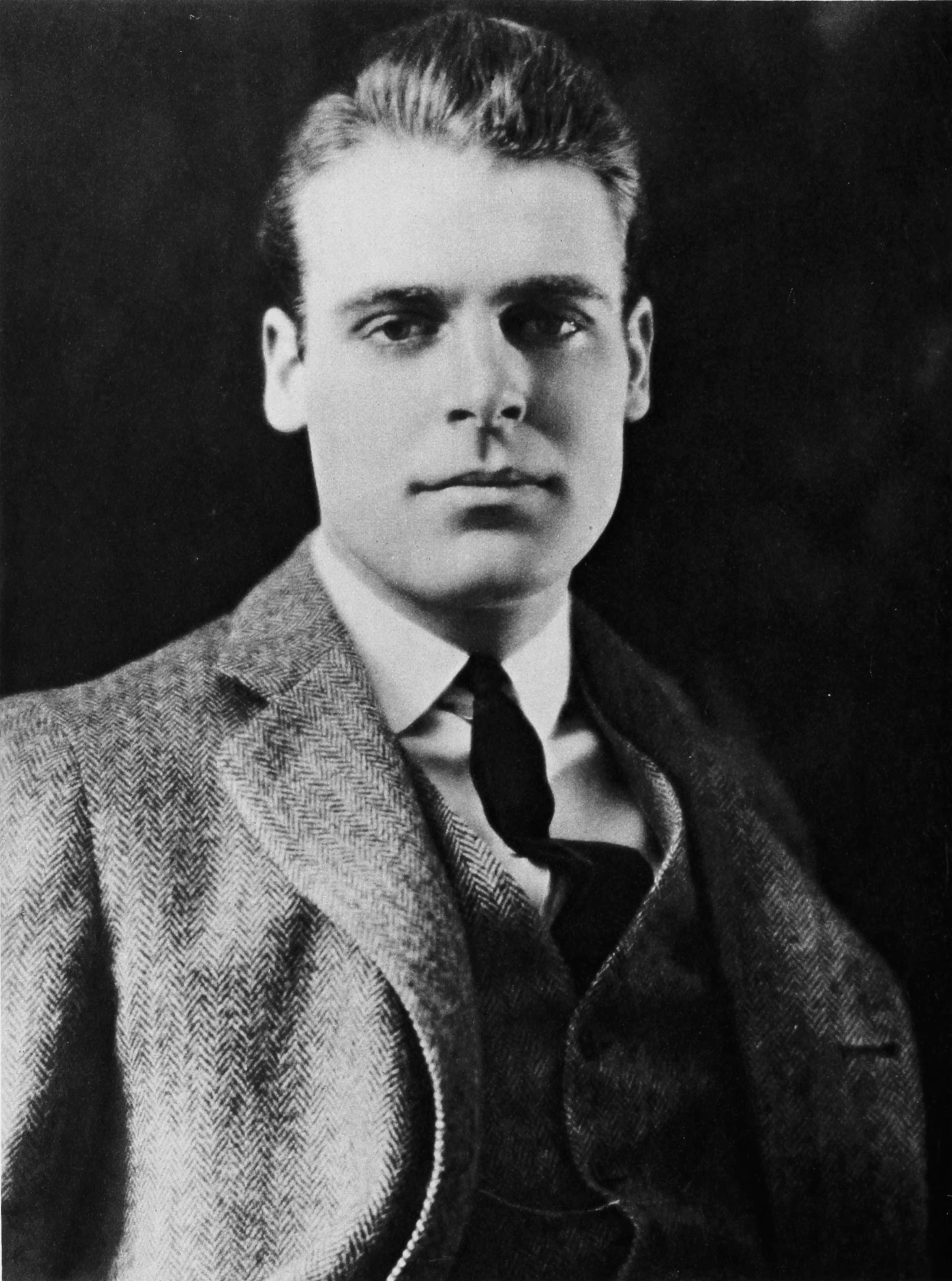|
Photokinema
''Photo-Kinema'' (some sources say ''Phono-Kinema'') was a sound-on-disc system for motion pictures invented by Orlando Kellum. 1921 introduction The system was first used for a small number of short films, mostly made in 1921. These films presented subjects such as actor Frederick Warde reading an original poem "A Sunset Reverie", labor leader Samuel Gompers speaking on labor issues, Judge Ben Lindsey on the need for a separate juvenile court system, Irvin S. Cobb reading from his works, and a lecture by James J. Davis, Secretary of Labor in the Harding administration. Kellum also filmed musical numbers, including a performance of the song "De Ducks" by African American musicians F. E. Miller and Aubrey Lyles who wrote the book for the musical '' Shuffle Along'' (1921), and ''The Famous Van Eps Trio in a Bit of Jazz'' (1921), featuring Fred Van Eps, father of musician George Van Eps. A filmed performance by Sir Harry Lauder made in Phono-Kinema is preserved at the U ... [...More Info...] [...Related Items...] OR: [Wikipedia] [Google] [Baidu] |
Dream Street (film)
''Dream Street'' is a 1921 American silent romantic drama film directed by D. W. Griffith, and starring Carol Dempster, Charles Emmett Mack, and Ralph Graves in a story about a love triangle set in London, and based on two short stories by Thomas Burke, "Gina of the Chinatown" and "The Sign of the Lamp". The cast also features Tyrone Power Sr. The film, released by United Artists, was poorly received in its day, and critics still consider it one of Griffith's worst films. Plot As described in a film magazine review, Gypsy Fair, a young dancer, is forced through circumstances to live in the London Limehouse district and associate with the other residents there. Through her courage and loyalty, she is forced into numerous hazardous situations from all of which she emerges unharmed. Finally, she marries the man she has reformed and finds true happiness with him. Cast Premiere The original 1921 version of ''Dream Street'' is notable for a brief sequence when D. W. Griffi ... [...More Info...] [...Related Items...] OR: [Wikipedia] [Google] [Baidu] |
Sound Film
A sound film is a Film, motion picture with synchronization, synchronized sound, or sound technologically coupled to image, as opposed to a silent film. The first known public exhibition of projected sound films took place in Paris in 1900, but decades passed before sound motion pictures became commercially practical. Reliable synchronization was difficult to achieve with the early sound-on-disc systems, and amplification and recording quality were also inadequate. Innovations in sound-on-film led to the first commercial screening of Short film, short motion pictures using the technology, which took place in 1923. Before sound-on-film technology became viable, soundtracks for films were commonly played live with organs or pianos. The primary steps in the commercialization of sound cinema were taken in the mid-to-late 1920s. At first, the sound films which included synchronized dialogue, known as "talking pictures", or "talkies", were exclusively shorts. The earliest feature fil ... [...More Info...] [...Related Items...] OR: [Wikipedia] [Google] [Baidu] |
Sound-on-disc
Sound-on-disc is a class of sound film processes using a phonograph or other disc to record or play back sound in sync with a motion picture. Early sound-on-disc systems used a mechanical interlock with the movie projector, while more recent systems use timecodes. Examples of sound-on-disc processes France * The Chronophone ( Léon Gaumont) "Filmparlants" and phonoscènes 1902–1910 (experimental), 1910–1917 (industrial)Thomas Louis Jacques Schmitt, « The genealogy of clip culture » in Henry Keazor, Thorsten Wübbena (dir.) ''Rewind, Play, Fast Forward'', transcript, United States * Vitaphone introduced by Warner Bros. in 1926 * Photokinema, short-lived system, invented by Orlando Kellum in 1921 (used by D. W. Griffith for '' Dream Street'') * Digital Theater Systems United Kingdom * British Phototone, short-lived UK system using 12-inch discs, introduced in 1928-29 ('' Clue of the New Pin'') Other * Systems with the film projector linked to a phonograph or cylinde ... [...More Info...] [...Related Items...] OR: [Wikipedia] [Google] [Baidu] |
Aubrey Lyles
Aubrey Lee Lyles (8 January 1884 – 28 July 1932), sometimes credited as A. L. Lyles, was an American vaudeville performer, playwright, songwriter, and lyricist. He appeared with Flournoy E. Miller as Miller and Lyles as a popular African-American comedy duo from 1905 until shortly before his death. in 1929 they appeared on film as grocers in the Vitaphone Varieties short comedy film '' They Know Their Groceries''. Biography Lyles was born in Jackson, Tennessee, and attended Fisk University in Nashville as a medical student. He began performing as one half of a comedy duo, Miller and Lyles, with his friend Flournoy Miller. From 1905, Miller and Lyles were hired by impresario Robert T. Motts to be resident playwrights with the Pekin Theater Stock Company in Chicago. They performed with the company in blackface, and in the show '' The Colored Aristocrats'' introduced the characters Steve Jenkins (Miller) and Sam Peck (Lyles), with which they would be associated for many y ... [...More Info...] [...Related Items...] OR: [Wikipedia] [Google] [Baidu] |
Silent Film
A silent film is a film without synchronized recorded sound (or more generally, no audible dialogue). Though silent films convey narrative and emotion visually, various plot elements (such as a setting or era) or key lines of dialogue may, when necessary, be conveyed by the use of inter- title cards. The term "silent film" is something of a misnomer, as these films were almost always accompanied by live sounds. During the silent era, which existed from the mid-1890s to the late 1920s, a pianist, theater organist—or even, in larger cities, an orchestra—would play music to accompany the films. Pianists and organists would play either from sheet music, or improvisation. Sometimes a person would even narrate the inter-title cards for the audience. Though at the time the technology to synchronize sound with the film did not exist, music was seen as an essential part of the viewing experience. "Silent film" is typically used as a historical term to describe an era of cinema p ... [...More Info...] [...Related Items...] OR: [Wikipedia] [Google] [Baidu] |
Fred Van Eps
Fred Van Eps (December 30, 1878 – November 22, 1960) was an American banjoist and banjo maker. The "Van Eps Recording Banjo" was a well-known model until 1930. He was the father of jazz guitarist George Van Eps. Biography Van Eps was born in Somerville, New Jersey, United States, and moved with his family to Plainfield in 1892. He learned to play the banjo and studied the phonograph cylinder recordings of Vess Ossman. In 1897 Van Eps was hired by Thomas Edison's National Phonograph Company in West Orange to work in studio engagements. Van Eps's cylinder recordings, often remakes of Ossman's tunes, sold well for Edison. Early ragtime banjo recordings by Van Eps included "A Bunch of Rags" (1900) and "A Ragtime Episode" (1902). He also recorded for a number of other companies, including Columbia (from 1904) and Victor (from 1910). The Van Eps Trio recorded steadily from 1912 to 1922. He also led other groups, such as the Van Eps Quartet, the Van Eps Specialty Four, and the ... [...More Info...] [...Related Items...] OR: [Wikipedia] [Google] [Baidu] |
Harry Lauder
Sir Henry Lauder (; 4 August 1870 – 26 February 1950)Russell, Dave"Lauder, Sir Henry (1870–1950)" ''Oxford Dictionary of National Biography'', Oxford University Press, 2004, online edition, January 2011, accessed 27 April 2014 was a Scottish singer, comedian and actor. Popular in both music hall and vaudeville theatre traditions; he achieved international success. He was described by Sir Winston Churchill as "Scotland's greatest ever ambassador", who "by his inspiring songs and valiant life, rendered measureless service to the Scottish race and to the British Empire." He became a familiar worldwide figure deploying his kilt and wikt:cromack, cromach (walking stick) as icons of Scottish national identity, Scottishness to huge acclaim, especially in America. Among his most popular songs were "Roamin' in the Gloamin'", "A Wee wikt:deoch an dorais, Deoch-an-Doris", "The End of the Road" and, a particularly big hit for him, "I Love a Lassie". Lauder's understanding of life ... [...More Info...] [...Related Items...] OR: [Wikipedia] [Google] [Baidu] |
Ben Lindsey (jurist)
Benjamin Barr Lindsey (November 25, 1869 – March 26, 1943) was an American judge and social reformer based in Denver during the Progressive Era. Early life Benjamin Barr Lindsey was born in Jackson, Tennessee, to former Confederate captain Landy Tunstall Lindsey. He was educated in the public schools and attended Southwest Baptist University (now Union University). His father committed suicide when Ben was 18, leaving him the sole support of his mother and her three younger children. He obtained employment in a real-estate office in Denver, where he studied law in his spare time. In despair over his slow progress in his law studies, he attempted suicide, but his gun misfired. In 1894, he entered the practice of law in Denver. In his work, he was often assisted by his wife, Henrietta, whom he had married in 1914. He was appointed to a vacancy in the county court in 1900. Juvenile court Lindsey was a pioneer in the establishment of the juvenile court system. Through ... [...More Info...] [...Related Items...] OR: [Wikipedia] [Google] [Baidu] |
Irvin S
Irvin is a male given name of Indo-European origin. In Old Gaelic, the meaning of the name is "freshwater" or "friend of the sea." It can also be used as a variant of Ervin, the Eastern European version of the German name Erwin, which means "friend of the army." In the Middle East, Arvin (آروین) is the Persian variant of the name, meaning "tested and experienced." Meanwhile, Arfin (عرفين) (earfayn) is the Arabic variant, meaning "trusty." In Arabic, the letter ''v'' is absent and is substituted with ''f.'' In the Balkans, particularly in Albania, Bosnia and Herzegovina, and Croatia, the name is used as an alternative to Ervin, the more popular variant in the region, with Irvin being a modern variation of the name. Among the former Yugoslav countries, the name may have been derived from the word irvas, meaning ''reindeer'' in Bosnian-Croatian-Serbian. It is used as a male given name in the region, but these countries also have a female equivalent: Irvina (for examp ... [...More Info...] [...Related Items...] OR: [Wikipedia] [Google] [Baidu] |
Thomas Edison
Thomas Alva Edison (February11, 1847October18, 1931) was an American inventor and businessman. He developed many devices in fields such as electric power generation, mass communication, sound recording, and motion pictures. These inventions, which include the phonograph, the motion picture camera, and early versions of the electric Incandescent light bulb, light bulb, have had a widespread impact on the modern industrial society, industrialized world. He was one of the first inventors to apply the principles of organized science and teamwork to the process of invention, working with many researchers and employees. He established the first industrial research laboratory. Edison was raised in the American Midwest. Early in his career he worked as a telegraph operator, which inspired some of his earliest inventions. In 1876, he established his first laboratory facility in Menlo Park, New Jersey, where many of his early inventions were developed. He later established a botanical ... [...More Info...] [...Related Items...] OR: [Wikipedia] [Google] [Baidu] |
Oxford University Press
Oxford University Press (OUP) is the publishing house of the University of Oxford. It is the largest university press in the world. Its first book was printed in Oxford in 1478, with the Press officially granted the legal right to print books by decree in 1586. It is the second-oldest university press after Cambridge University Press, which was founded in 1534. It is a department of the University of Oxford. It is governed by a group of 15 academics, the Delegates of the Press, appointed by the Vice Chancellor, vice-chancellor of the University of Oxford. The Delegates of the Press are led by the Secretary to the Delegates, who serves as OUP's chief executive and as its major representative on other university bodies. Oxford University Press has had a similar governance structure since the 17th century. The press is located on Walton Street, Oxford, Walton Street, Oxford, opposite Somerville College, Oxford, Somerville College, in the inner suburb of Jericho, Oxford, Jericho. ... [...More Info...] [...Related Items...] OR: [Wikipedia] [Google] [Baidu] |
Ralph Graves
Ralph Graves (born Ralph Horsburgh; January 23, 1900 – February 18, 1977) was an American screenwriter, film director and actor who appeared in more than 90 films between 1918 and 1949. Biography Born in Cleveland, Ohio, Graves had already been cast in 46 films, half of them produced by Mack Sennett, before he wrote, directed, and starred in ''Swell Hogan'' in 1926. That film was produced by Howard Hughes, whose father had once supported the young actor in the early stages of his career by placing him on the payroll of the Hughes Tool Company between screen assignments, even though Graves never actually worked there. Graves and the younger Hughes met on the Wilshire Country Club golf course, and over lunch the actor Pitch (filmmaking), pitched a film about a Bowery bum who adopts a baby. The plot intrigued Hughes, who had a strong interest in Hollywood, and he invested $40,000 in the project. During filming he sat on the sidelines in order to familiarize himself with the ... [...More Info...] [...Related Items...] OR: [Wikipedia] [Google] [Baidu] |






